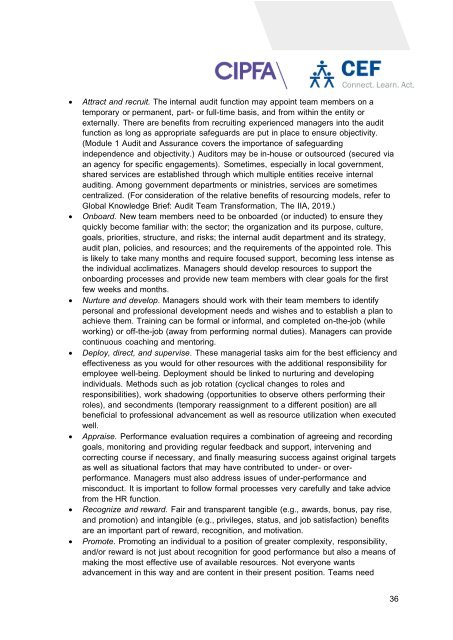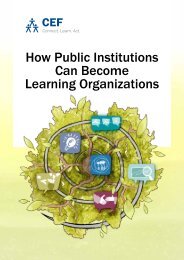TIAPS ALB_Module 2B. Managing People
- No tags were found...
Create successful ePaper yourself
Turn your PDF publications into a flip-book with our unique Google optimized e-Paper software.
• Attract and recruit. The internal audit function may appoint team members on a<br />
temporary or permanent, part- or full-time basis, and from within the entity or<br />
externally. There are benefits from recruiting experienced managers into the audit<br />
function as long as appropriate safeguards are put in place to ensure objectivity.<br />
(<strong>Module</strong> 1 Audit and Assurance covers the importance of safeguarding<br />
independence and objectivity.) Auditors may be in-house or outsourced (secured via<br />
an agency for specific engagements). Sometimes, especially in local government,<br />
shared services are established through which multiple entities receive internal<br />
auditing. Among government departments or ministries, services are sometimes<br />
centralized. (For consideration of the relative benefits of resourcing models, refer to<br />
Global Knowledge Brief: Audit Team Transformation, The IIA, 2019.)<br />
• Onboard. New team members need to be onboarded (or inducted) to ensure they<br />
quickly become familiar with: the sector; the organization and its purpose, culture,<br />
goals, priorities, structure, and risks; the internal audit department and its strategy,<br />
audit plan, policies, and resources; and the requirements of the appointed role. This<br />
is likely to take many months and require focused support, becoming less intense as<br />
the individual acclimatizes. Managers should develop resources to support the<br />
onboarding processes and provide new team members with clear goals for the first<br />
few weeks and months.<br />
• Nurture and develop. Managers should work with their team members to identify<br />
personal and professional development needs and wishes and to establish a plan to<br />
achieve them. Training can be formal or informal, and completed on-the-job (while<br />
working) or off-the-job (away from performing normal duties). Managers can provide<br />
continuous coaching and mentoring.<br />
• Deploy, direct, and supervise. These managerial tasks aim for the best efficiency and<br />
effectiveness as you would for other resources with the additional responsibility for<br />
employee well-being. Deployment should be linked to nurturing and developing<br />
individuals. Methods such as job rotation (cyclical changes to roles and<br />
responsibilities), work shadowing (opportunities to observe others performing their<br />
roles), and secondments (temporary reassignment to a different position) are all<br />
beneficial to professional advancement as well as resource utilization when executed<br />
well.<br />
• Appraise. Performance evaluation requires a combination of agreeing and recording<br />
goals, monitoring and providing regular feedback and support, intervening and<br />
correcting course if necessary, and finally measuring success against original targets<br />
as well as situational factors that may have contributed to under- or overperformance.<br />
Managers must also address issues of under-performance and<br />
misconduct. It is important to follow formal processes very carefully and take advice<br />
from the HR function.<br />
• Recognize and reward. Fair and transparent tangible (e.g., awards, bonus, pay rise,<br />
and promotion) and intangible (e.g., privileges, status, and job satisfaction) benefits<br />
are an important part of reward, recognition, and motivation.<br />
• Promote. Promoting an individual to a position of greater complexity, responsibility,<br />
and/or reward is not just about recognition for good performance but also a means of<br />
making the most effective use of available resources. Not everyone wants<br />
advancement in this way and are content in their present position. Teams need<br />
36
















